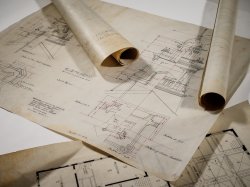It’s Back to the Future for Montclair State’s Iconic College Hall
Renovation builds on an historic past
Posted in: University

For more than a century, College Hall has been the iconic face of Montclair State University. When it opened its doors as New Jersey State Normal School at Montclair in September 1908, the Mission Revival building not only housed the entire school, but it also immediately established a lasting identity for the fledgling institution. This signature style defines the Montclair State campus to this day.
College Hall is currently undergoing an ambitious renovation and expansion project. “After more than a century of use, it will be restored in all its glory to continue to be our flagship and icon for the next 100 years,” says University Architect Frank Cunha.
Birth of an Icon
In 1903, after it became apparent that the New Jersey State Normal School in Trenton was unable to singlehandedly meet a growing need for trained teachers, the state approved plans for a second normal school. The new school, located on a plot of land in Montclair, needed a home.
Enter Edward Russ — a prominent lawyer and chair of the New Jersey State Board of Education’s Normal School Committee. During a trip to California, he had been captivated by the 18th– and 19th– century Spanish missions that dotted the state’s coastline.
Russ soon convinced state architect George E. Poole to design the new normal school in the hugely popular Mission Revival style. Inspired by the same historic Spanish missions that Russ had so admired in California, Mission Revival buildings are readily identified by their plain white exterior plaster walls, colorful clay roof tiles, arched entries and windows, and simple wood, iron and tile decorative touches.
Once Poole’s design was approved, Newark contractor Frederick Kilgus—who submitted the lowest bid of $198,000–was awarded the construction contract. After breaking ground with a silver shovel on March 8, 1907, Russ regularly visited the College Hall construction site to check on the building’s progress.
That Was Then
The finished building was dedicated in March 1908, at a ceremony attended by New Jersey Governor John Franklin Fort. The white, orange-tiled building’s 125,000 square feet were home to everything from administrative offices and classrooms to the new normal school’s library and gym. In keeping with its Mission Revival style, it even featured a bell tower—complete with an antique 200-year-old mission bell donated by Russ.
Original blueprints show that College Hall’s basement level featured two recreation rooms, as well as separate “boys” and “girls” dressing and locker rooms, and lunchrooms. The first floor included a spacious gymnasium and study hall, as well as classrooms that were designated for everything from classics and geology to literature and geography. On the second floor classrooms were allocated to the sciences and to a drawing studio and darkrooms, as well as the “upper parts” of the gym and study hall.
Most recently, College Hall has functioned as the University’s administrative hub, housing offices of the President and the Provost, University Advancement, Human Resources, Admissions, the Registrar, Student Accounts, Financial Aid and The Graduate School.
This Is Now
When the current restoration and expansion project, which is managed by University Facilities Senior Project Manager Sharon Mahoney, is completed in 2020, College Hall will provide a consolidated center for Montclair State’s broad array of Student Services. It will house offices for Admissions, Career Services, Student Development and Campus Life, and more. It will also feature newly configured offices for the President and Provost.
Cunha describes College Hall’s planned atrium addition, which will face Sprague Library as, “an elegant blend of modern architecture that distinguishes itself from the historic building while simultaneously presenting a new and improved face to the North campus.” It will include a new lower level IT facility, “Red Hawk Central” student service support center, as well as student lounge areas.
Additionally, a new portico on the West side of the building will serve as an entryway for a new café and Undergraduate Admissions.
The old building will otherwise remain aesthetically intact. “All of the original historic features will be restored to their glorious days from the early 1900s,” explains Cunha. “The stucco, woodwork, windows and roof will be replaced to match the original look.”
A Lasting Identity
From the beginning, the University used College Hall as a model to strengthen its identity. Chapin Hall, Morehead Hall and Russ Hall–the three other original campus buildings built shortly after College Hall–were also built in the Mission Revival style.
“Since her arrival, President Cole has led the University in a return to our foundation in the Mission Revival style, in both new buildings as well as renovations of older buildings,” says Cunha. As he sees it, with the new renovation, College Hall will be an even stronger icon and expression of the campus identity.
